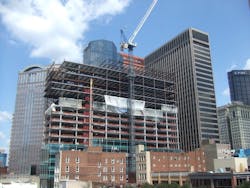Leadership or limbo: Moving to building green’s next level
It is indisputable that buildings are more efficient and sustainable than they’ve ever been. What once were one-off installations, from cogeneration systems to graywater recapture, are becoming standard. And despite uncertain government subsidies, renewable energy alternatives are at the point of acceptance in several markets.
However, after interviewing more than 50 AEC firms for our Greenbuild Report, I wonder if the nonresidential construction sector has hit a wall, where codes and standards not only set the bar for high-performance buildings, but also set the limit above which projects are less likely to venture.
To hear some architects, engineers, and contractors tell it, clients outside of federal and state agencies are concerned primarily with how much their buildings are going to cost to run, and only the rarest of this clan are willing to invest in designs or materials that go much beyond what’s minimally required, or in marketing that highlights these features to prospective customers.
And while there’s been much talk about how Millennials actively seek out live and workplaces that conform to their supposed inclinations toward environmental stewardship, there’s scant evidence that corroborates how these attitudes translate into decisions about choosing hotels, schools, homes, medical centers, or employers.
The irony is that AEC firms we spoke with had no trouble coming up with any number of examples of high-performance reconstructions or new builds that are saving energy and money, and contribute to reducing the built environment’s still-mammoth carbon footprint. The question is whether these firms are making their cases strongly enough to overcome the marketplace’s resistance or indifference to recognizing its role in this effort.
“It’s not enough to know that it’s the right thing for a building; you must be able to explain why,” said Jeff Boldt, Principal and Director of Engineering with KJWW Engineering Consultants.
A good place to start is convincing developers and owners about the benefits of hiring the whole Building Team as early as possible. Time and again AEC executives recounted how early collaboration helped refine a client’s vision and set in motion solutions that, as often as not, took that vision to higher levels of efficiency and sustainability.
It certainly helps that the AEC industry, in conjunction with software manufacturers, is taking more seriously the need to develop genuinely collaborative tools that provide a common platform for these kinds of discussions among the broadest array of stakeholders, including owners, property managers, and even end-users of buildings.
As was pointed out at a recent technology symposium conducted by the engineering firm Thornton Tomasetti, the Internet of Things, combined with sensor technology, is starting to generate a blizzard of data about how buildings perform—and will need to perform better as their environments and demographics change.
Being able to disseminate and analyze these data to offer actionable design and construction solutions is already a competitive advantage for forward-thinking AEC firms. So will be keeping up with the rate of change that finds codes and standards trailing innovation. AEC firms that aspire to leadership positions in energy efficiency, sustainability, and—to a growing degree—resiliency, should no longer accept “client’s prerogative” as an excuse for submitting to the status quo.

